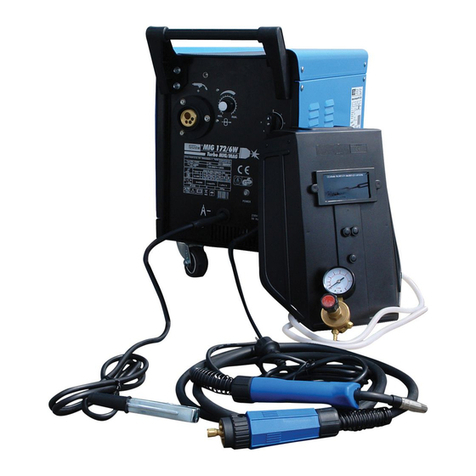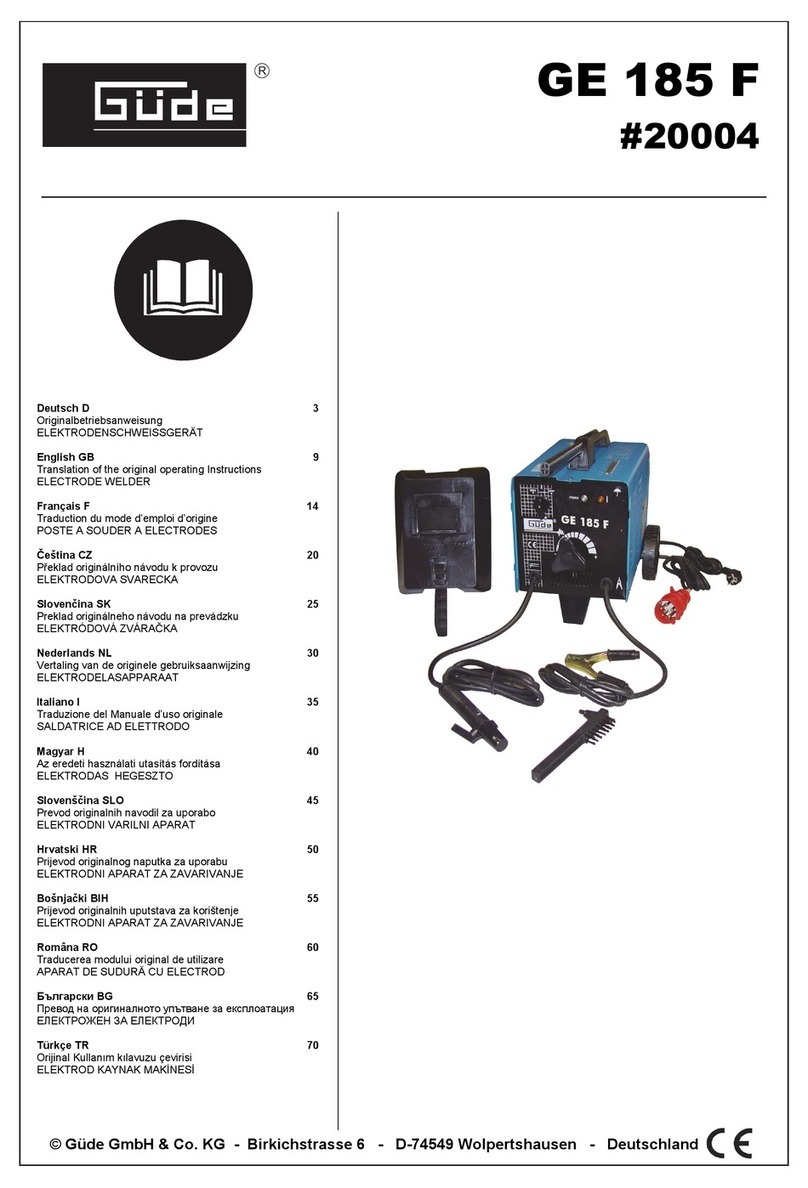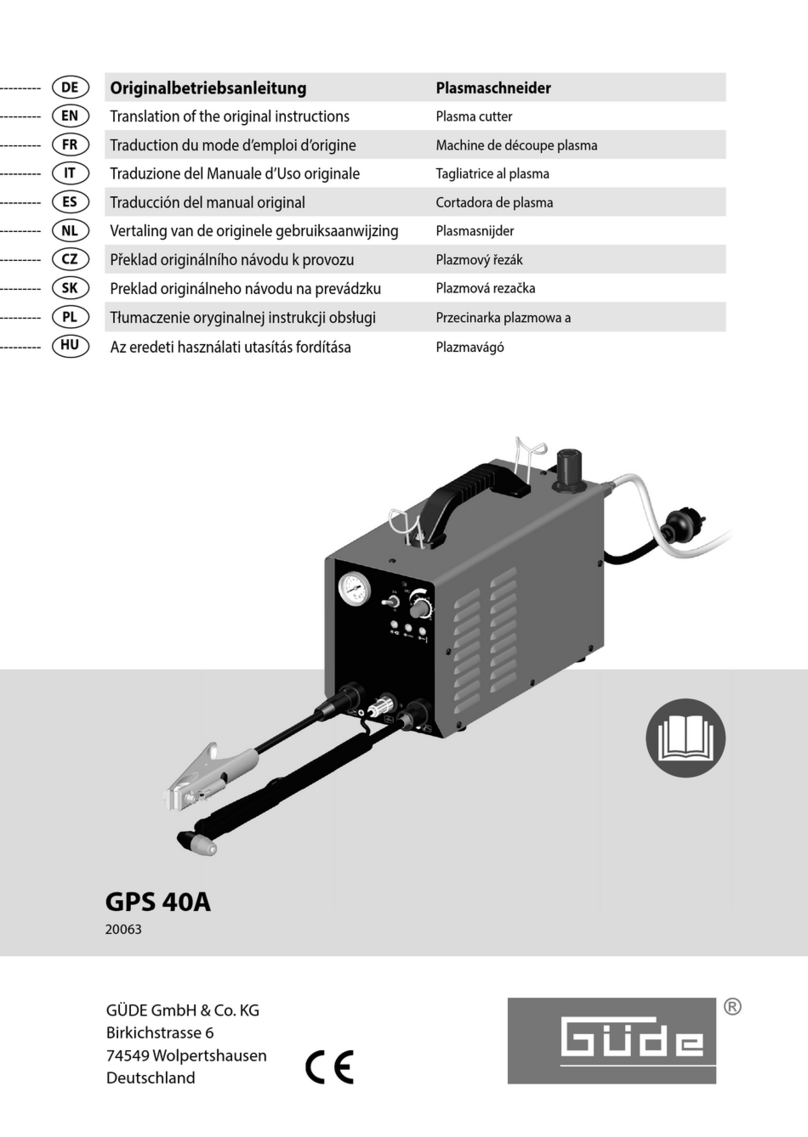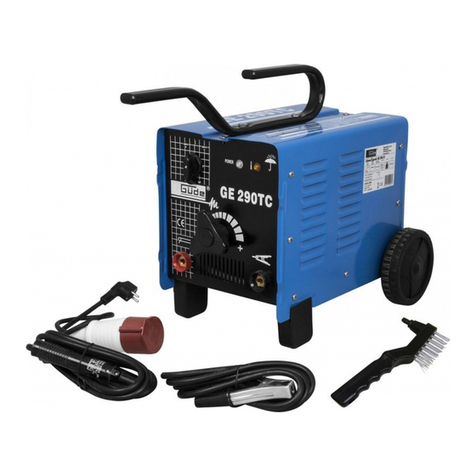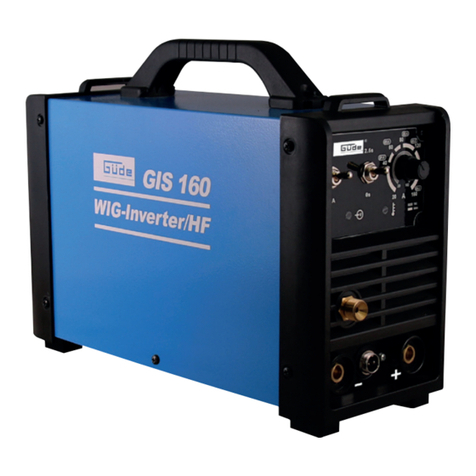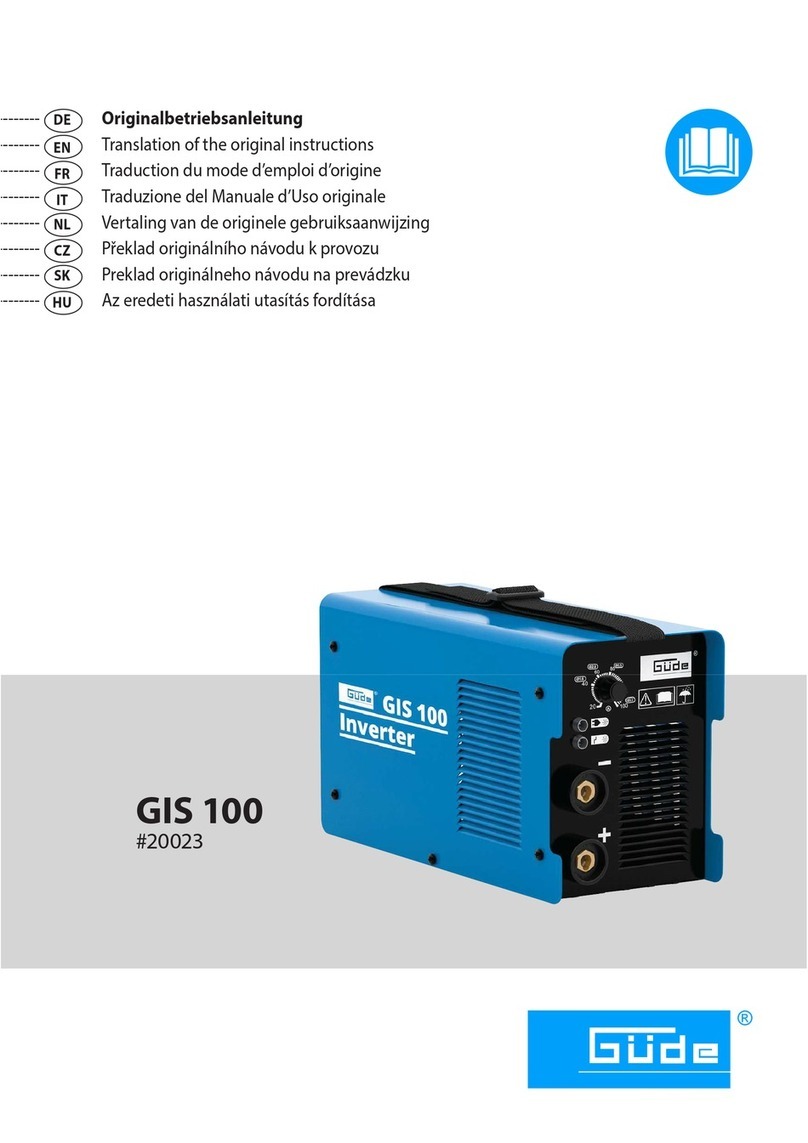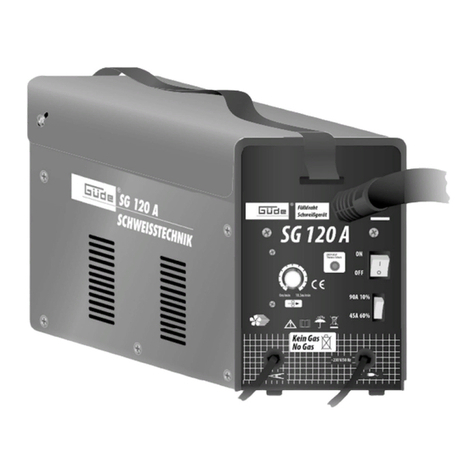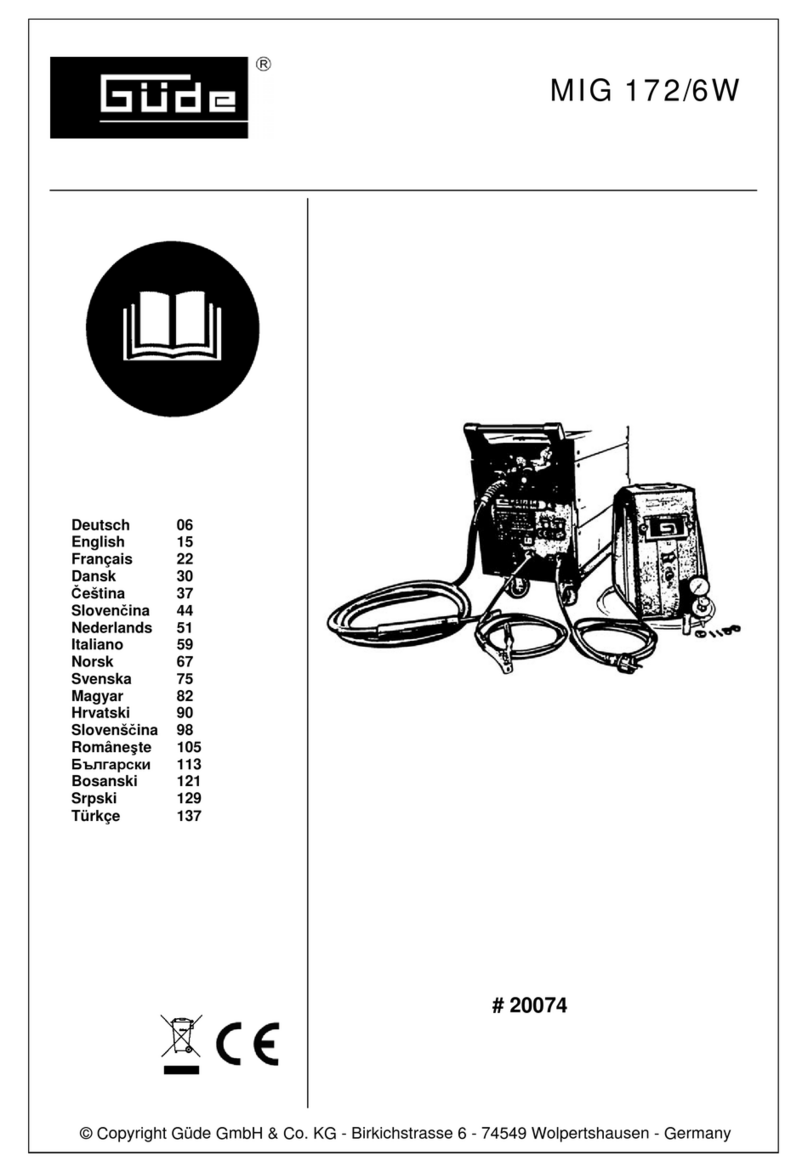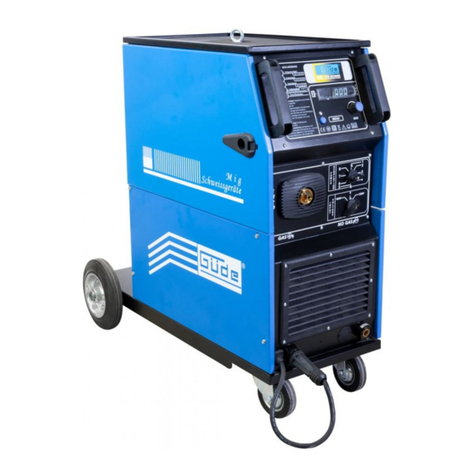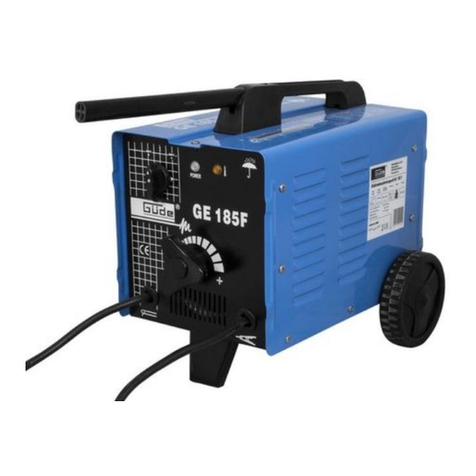
H: Isolationsklasse
1~50 Hz: Wechselstromsymbol und
Bemessungswert der Frequenz
Gerät
Das Gehäuse besteht aus pulverbeschichtetem Stahlblech,
mit integriertem Thermo-Überlastschutz.
Gerätebeschreibung Abb. 1
1. Schweißgerät
2. Schweißschild
3. Elektrodenhalter
4. Schlackenhammer/Bürste
5. Masseklemme
6. Kontrolllampe „Thermoschutz“
7. Ein/Aus Schalter
8. Schweißstromregulator
DE EG-Konformitätserklärung
Hiermit erklären wir,
Güde GmbH & Co. KG
Birkichstraße 6
74549 Wolpertshausen
Germany
Dass die nachfolgend bezeichneten Geräte aufgrund ihrer
Konzipierung und Bauart sowie in den von uns in Verkehr gebrachten
Ausführungen den einschlägigen, grundlegenden Sicherheits- und
Gesundheitsanforderungen der EG-Richtlinien entsprechen.
Bei einer nicht mit uns abgestimmten Änderung der Geräte
verliert diese Erklärung ihre Gültigkeit.
Bezeichnung der Geräte: Elektrodenschweissgerät GE 145 W
Artikel-Nr.: 20001
Datum/Herstellerunterschrift: 17.10.2008
Angaben zum Unterzeichner: Hr. Arnold, Geschäftsführer
Technische Dokumentation: J. Bürkle; FBL, QS
Einschlägige EG-Richtlinien:
2006/42 EG
2006/95 EG
2004/108 EG
Angewandte harmonisierte Normen:
EN 60974-1: 2005
EN 60974-10: 2003
EN 60974-6: 2003
ZEK 01.1-08/06.08
Zertifizierstelle:
TÜV Rheinland Product Safety, Am Grauen Stein, D-51112 Köln
Gewährleistung
Die Gewährleistung erstreckt sich ausschließlich auf Mängel,
die auf Material- oder Herstellungsfehler zurückzuführen sind.
Bei Geltendmachung eines Mangels im Sinne der
Gewährleistung ist der original Kaufbeleg mit Verkaufdatum
beizufügen.
Von der Gewährleistung ausgeschlossen sind unsachgemäße
Anwendungen, wie z. B. Überlastung des Gerätes,
Gewaltanwendung, Beschädigungen durch Fremdeinwirkung
oder durch Fremdkörper. Nichtbeachtung der Gebrauchs- und
Aufbauanleitung und normaler Verschleiß sind ebenfalls von
der Gewährleistung ausgeschlossen.
Bestimmungsgemäße Verwendung
Das Gerät ist nicht für den gewerblichen Einsatz geeignet.
Das Schweißgerät ist bestimmt für das Verschweißen von
Metallen, die mit Elektroden geschweißt werden können. Das
Schweißgerät und die dazugehörige Schweißplatzausrüstung
entsprechen bei Auslieferung den einschlägigen
Bestimmungen.
Bei Nichtbeachtung der Bestimmungen, aus den allgemein
gültigen Vorschriften sowie den Bestimmungen aus dieser
Anleitung, kann der Hersteller für Schäden nicht
verantwortlich gemacht werden.
Wichtige grundlegende Sicherheitshinweise
Bevor Sie mit dem Gerät arbeiten, lesen Sie die
nachstehenden Sicherheitsvorschriften und die
Bedienungsanleitung aufmerksam durch. Falls Sie das
Gerät an andere Personen übergeben sollten, händigen Sie
die Bedienungsanleitung bitte mit aus. Bewahren Sie die
Bedienungsanleitung immer gut auf!
Verpackung: Ihr Gerät befindet sich zum Schutz vor
Transportschäden in einer Verpackung. Verpackungen sind
Rohstoffe und somit wiederverwendungsfähig oder können
dem Rohstoffkreislauf zurückgeführt werden.
Bitte lesen Sie die Gebrauchsanweisung sorgfältig durch
und beachten Sie deren Hinweise. Machen Sie sich anhand
dieser Gebrauchsanweisung mit dem Gerät, dem richtigen
Gebrauch sowie den Sicherheitshinweisen vertraut. Bitte
bewahren Sie die Hinweise für späteren Gebrauch sicher
auf.
Das Gerät darf nur von Personen bedient werden, die
die vorliegenden Anleitungen ausführlich gelesen und
verstanden haben; das Gerät darf nicht von Personen
bedient werden, die nicht angemessen eingewiesen
sind oder sich in einem bedenklichen
Gesundheitszustand befinden.
Führen Sie vor jeder Benutzung eine Sichtprüfung des
Gerätes durch. Benutzen Sie das Gerät nicht, wenn
Sicherheitsvorrichtungen beschädigt oder abgenutzt
sind. Setzen Sie nie Sicherheitsvorrichtungen außer
Kraft.
Verwenden Sie das Gerät ausschließlich entsprechend
dem in dieser Gebrauchsanweisung angegebenen
Verwendungszweck.
Arbeiten Sie stets aufmerksam. Beobachten Sie Ihre
Arbeit. Gehen Sie vernünftig vor. Verwenden Sie das
Gerät nicht, wenn Sie unkonzentriert sind.
Sie sind für die Sicherheit im Arbeitsbereich
verantwortlich.
Lassen Sie das Gerät nie unbeaufsichtigt.
Sollten Sie die Arbeit unterbrechen, lagern Sie bitte
das Gerät an einem sicheren Ort.
Benutzen Sie das Gerät nie bei Regen oder in
feuchter, nasser Umgebung.
Schalten Sie das Gerät nicht ein, wenn es umgedreht
ist bzw. wenn es nicht in der Arbeitsstellung ist.
Halten Sie das Gerät von anderen Personen,
insbesondere Kindern und auch von Haustieren fern.
Lassen Sie andere Personen nicht das Werkzeug oder
Kabel berühren,
Ziehen Sie nach dem Gebrauch den Netzstecker und
überprüfen Sie die Maschine auf Beschädigung.
Wenn Sie das Gerät nicht benutzen, bewahren Sie es
an einem trockenen und für Kinder unzugänglichen Ort
auf.
Die Netzspannung muss mit der Spannung
übereinstimmen, die auf dem Typenschild angegeben
ist.
Reparaturen dürfen nur von einem Elektrofachmann
durchgeführt werden.
Vor Inbetriebnahme der Maschine und nach
irgendwelchem Aufprall, prüfen Sie das Gerät auf
Anzeichen von Verschleiß oder Beschädigung, und
lassen Sie notwendige Reparaturen durchführen.
Benutzen Sie nie Ersatz- und Zubehörteile, die vom
Hersteller nicht vorgesehen oder empfohlen sind.
Benutzen Sie die Maschine nur bei Tageslicht oder mit
ausreichender künstlicher Beleuchtung.
Achten Sie darauf, dass andere Gegenstände keinen
Kurzschluss an den Kontakten des Geräts verursachen.
Verlegen Sie alle Leitungen so, dass keine Stolpergefahr
entsteht und eine Beschädigung des Kabels
ausgeschlossen ist!
